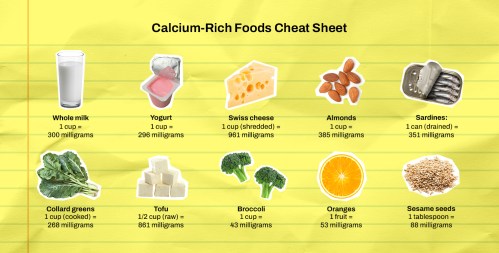When we think of foods high in calcium, the first thing that may come to mind is: Got milk? But according to registered dietitian Lauren Manaker, RDN, a crisp, cold glass of milk isn’t the only source of calcium for healthy bones; there are many foods that can help up your calcium intake, including plant-based ones.
Experts in This Article
registered dietitian and prenatal and postnatal health expert
Finding new ways to help support bone health can especially come in handy as calcium needs change as you age or as shifts in hormones affect bone density during menopause. In fact, research shows that 1 in 2 Americans over the age of 50 are at risk for developing osteoporosis—a type of bone disease defined by loss in bone mineral density and mass, per a January-February 2023 review in Orthopedics1.
Ahead, Manaker shares an easily digestible (pun intended) guide for how much calcium you should aim for each day, plus a calcium “cheat sheet” with the top foods highest in this nutrient to help you easily meet your daily quotas.
How much calcium should I have a day?
Recommended calcium intake can vary based on several factors, including age and life stage, Manaker says. But there are a few general guidelines to follow that can help define the appropriate quantities to get daily.
According to Manaker, the sweet spot for daily calcium intake is around 1,000 milligrams for most adults, 1,200 milligrams for women over age 50 and men over age 70 (who are at higher risk for bone density loss), and 1,300 milligrams for children and adolescents (to support growing bones and teeth).
Manaker also notes that a person who is pregnant or breastfeeding/chestfeeding should also aim for higher quantities of calcium than the baseline recommendations. “This helps support their own health and the development of their baby,” Manaker explains. For context, the World Health Organization recommends pregnant people get about 1,200 milligrams of calcium per day, per a 2020 study in the European Journal of Nutrition2.
Recommended calcium intake per day:
- Adults: 1,000 milligrams
- Women over 50 and men over 70: 1,200 milligrams
- Children and adolescents: 1,300 milligrams
- Pregnant or breastfeeding people: 1,200 milligrams
How much calcium should you get per meal?
Manaker recommends breaking up calcium intake throughout the day, especially if you need a higher amount to meet your dietary requirements. “The body can only absorb a limited amount of calcium at one time, typically around 500 milligrams,” she says. “Consuming smaller doses of calcium-rich foods or supplements at different times can enhance absorption and optimize its benefits for bone health,” she adds.
Spreading out intake can also help reduce any potential side effects that may affect digestion. “Too much calcium at once can result in bloating or constipation,” Manaker says. With that said, she also recommends pairing calcium with vitamin D to help maximize absorption—like salmon with spinach, kale and mushrooms, or fortified orange juice.
5 health benefits of calcium
1. It supports bone health
Indeed, calcium is crucial for the development and maintenance of strong bones and teeth, says Manaker. “Adequate calcium intake helps prevent bone density loss and reduces the risk of osteoporosis and fractures, particularly in older adults,” she adds. In fact, calcium supplementation may help reduce bone loss by 0.5 to 1.2 percent, and the risk of fractures by at least 10 percent in older adults, per an August 2012 review in Clinical Biochemistry3.
2. It promotes proper muscle function
According to Manaker, calcium plays a key role in muscle contraction, including the functioning of your heart muscle. “Consuming enough of it ensures that muscles can contract and relax properly,” she says. Research backs this up: A February 2015 review in Cold Spring Harbor Perspectives in Biology4 found adequate calcium consumption affects several calcium-dependent signaling pathways, including regulating muscle contraction.
3. It helps regulate blood clotting
Calcium also plays a critical role in the regulation of your blood. “It’s a vital component of the blood clotting process. It aids in the conversion of prothrombin into thrombin, a critical step in the formation of blood clots,” Manaker explains. Studies show5 low blood levels of calcium is linked to longer bleeding times, which can increase the risk of hematoma size for patients with intracerebral hemorrhage (a type of stroke), in particular.
4. It supports nerve function
Calcium is essential for nerve function, says Manaker. “It helps transmit nerve impulses that are necessary for various bodily functions and movement,” she says. Studies show that calcium functions as a “second messenger” that helps support eukaryotic cells6, which is key for carrying out various metabolic functions.
5. It may help regulate the metabolism
Manaker explains that calcium can also potentially help support metabolic function. “Some studies7 suggest that calcium plays a role in maintaining a healthy weight,” she says. “It works in conjunction with other hormones and enzymes involved in weight regulation,” she explains. That said, more research is needed on the topic to conclusively determine this correlation.
10 foods rich in calcium
1. Milk
“A traditional and accessible source of calcium, milk is not only essential for developing strong bones and teeth but also enriched with vitamin D, which aids in absorption of the nutrient,” Manaker says.
Whole milk: 1 cup = 300 milligrams of calcium
2. Yogurt
“Packed with calcium and probiotics, yogurt supports bone health while promoting a healthy digestive system and boosting immunity,” Manaker explains. On that note, these are some of Manaker’s all-time favorite probiotic-rich yogurts on the market.
Yogurt: 1 cup = 296 milligrams of calcium
3. Cheese
“Rich in calcium and protein, cheese contributes to strong bones and teeth. It also contains phosphorus, which works alongside calcium to enhance bone density,” Manaker says. In fact, a cup of shredded Swiss cheese, in particular, has by far the highest amounts of calcium per serving than any other food on the list.
Swiss cheese: 1 cup (shredded) = 961 milligrams of calcium
4. Almonds
“These nutrient-dense nuts offer a significant amount of calcium along with healthy fats, fiber, and protein, supporting both bone health and reducing the risk of heart disease,” Manaker says.
Almonds: 1 cup = 385 milligrams of calcium
5. Sardines
It’s no surprise why sardines are often considered the best fish for boosting longevity. “These small, oily fish are high in calcium and omega-3 fatty acids, which are beneficial for bone strength and cardiovascular health. Opt for the sardines that still have the bones for the extra boost,” Manaker says.
Sardines: 1 can (drained) = 351 milligrams of calcium
6. Leafy greens
“Vegetables, like kale, collard greens, and bok choy, are excellent plant-based sources of calcium. They also provide vitamins and antioxidants, which contribute to overall health,” Manaker says. Eating a cup of leafy greens a day can also help reduce your risk of heart disease.
Collard greens: 1 cup (cooked) = 268 milligrams of calcium
7. Tofu
“A versatile, calcium-fortified soy product, tofu offers a great plant-based protein option that supports bone health and muscle function, especially for vegetarians and vegans,” Manaker explains. You’ll want to try these five delicious crispy air fryer tofu recipes next.
Tofu: 1/2 cup (raw) = 861 milligrams of calcium
8. Broccoli
“Broccoli is not only a good source of calcium, but also contains vitamin K and magnesium, which are crucial for bone health and reducing the risk of osteoporosis,” Manaker says.
Broccoli: 1 cup = 43 milligrams of calcium
9. Oranges
“This citrus fruit not only boosts the immune system with vitamin C but also provides a good amount of calcium and vitamin D, enhancing bone health and overall well-being,” Manaker says. Cara Cara oranges are some of our favorite kinds loaded with these impressive benefits.
Oranges: 1 fruit = 53 milligrams of calcium
10. Sesame seeds
Small but mighty, sesame seeds contain boatloads of nutrients. “High in calcium, sesame seeds also contain magnesium, phosphorus, and zinc, all of which are important for maintaining healthy bones and teeth. They can be easily added to different dishes for an added nutritional boost,” Manaker says.
Sesame seeds: 1 tablespoon = 88 milligrams of calcium

Calcium-rich foods cheat sheet
Depending on your daily calcium needs, this list can help you reach your goals without having to think twice:
- Whole milk: 1 cup = 300 milligrams
- Yogurt: 1 cup = 296 milligrams
- Swiss cheese: 1 cup = 961 milligrams
- Almonds: 1 cup = 385 milligrams
- Sardines: 1 can (drained) = 351 milligrams
- Collard greens: 1 cup (cooked) = 268 milligrams
- Tofu: 1/2 cup (raw) = 861 milligrams
- Broccoli: 1 cup = 43 milligrams
- Oranges: 1 fruit = 53 milligrams
- Sesame seeds: 1 tablespoon = 88 milligrams
How to get calcium if you can’t have dairy
As we’ve learned above, there are plenty of sources of calcium that aren’t dairy—perfect for vegans, vegetarians, or those with an intolerance or allergy. “Almonds, leafy greens like kale and collard greens, and calcium-fortified products such as tofu and plant-based milks provide substantial amounts of the nutrient,” Manaker says.
Manaker also recommends incorporating other lactose-free, calcium-rich foods in your diet. “Small fish like sardines, especially those with edible bones, are excellent for boosting intake. It’s also helpful to incorporate other nutrient-dense foods like broccoli, oranges, and sesame seeds, which offer calcium along with other vitamins and minerals essential for bone health,” she says.
Some other good news? Manaker says lactose-intolerant folks don’t necessarily need to cut out all dairy products from their diet. “Many lactose-intolerant individuals can tolerate small amounts of lactose without discomfort,” she explains. If that’s the case, Manaker says hard cheeses like cheddar, Swiss, and Parmesan have less lactose compared to soft cheeses and milk, making them potentially easier to digest for some folks. “Additionally, yogurt with live active cultures can aid in the digestion of lactose due to the presence of good bacteria,” she adds.
Of course, there are always lactose-free milk and dairy products that Manaker says offer “the same nutritional benefits without causing digestive issues.” On the other hand, if you choose to go the calcium supplement route, Manaker recommends speaking with your health care provider to make sure it’s right for you.
Sabri, Shahbaaz A et al. “Osteoporosis: An Update on Screening, Diagnosis, Evaluation, and Treatment.” Orthopedics vol. 46,1 (2023): e20-e26. doi:10.3928/01477447-20220719-03
↩︎Willemse, Jessica P M M et al. “Calcium intake from diet and supplement use during early pregnancy: the Expect study I.” European journal of nutrition vol. 59,1 (2020): 167-174. doi:10.1007/s00394-019-01896-8
↩︎Zhu, Kun, and Richard L Prince. “Calcium and bone.” Clinical biochemistry vol. 45,12 (2012): 936-42. doi:10.1016/j.clinbiochem.2012.05.006
↩︎Kuo, Ivana Y, and Barbara E Ehrlich. “Signaling in muscle contraction.” Cold Spring Harbor perspectives in biology vol. 7,2 a006023. 2 Feb. 2015, doi:10.1101/cshperspect.a006023
↩︎Morotti, Andrea et al. “Association Between Serum Calcium Level and Extent of Bleeding in Patients With Intracerebral Hemorrhage.” JAMA neurology vol. 73,11 (2016): 1285-1290. doi:10.1001/jamaneurol.2016.2252
↩︎Schavemaker, Paul E, and Sergio A Muñoz-Gómez. “The role of mitochondrial energetics in the origin and diversification of eukaryotes.” Nature ecology & evolution vol. 6,9 (2022): 1307-1317. doi:10.1038/s41559-022-01833-9
↩︎Ian R. Reid, Anne Horne, Barbara Mason, Ruth Ames, Usha Bava, Gregory D. Gamble, Effects of Calcium Supplementation on Body Weight and Blood Pressure in Normal Older Women: A Randomized Controlled Trial, The Journal of Clinical Endocrinology & Metabolism, Volume 90, Issue 7, 1 July 2005, Pages 3824–3829, https://doi.org/10.1210/jc.2004-2205
↩︎
Sign Up for Our Daily Newsletter
Get all the latest in wellness, trends, food, fitness, beauty, and more delivered right to your inbox.
Got it, you've been added to our email list.











